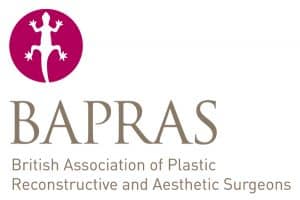
Scars
Everything you need to know about scars
10 Harley Street
London W1G 9PF
Everything About SCARS
Every surgical procedure involves formation of a permanent scar, and it’s final appearance is the result of a long maturation process that takes months or even years.
In the plastic surgery field, we use special suturing techniques and suturing materials in order to produce a scar that is as inconspicuous as possible.
However in some cases, there are undesirable factors that invariably lead to a pathological maturation of the scar, with noticeable worsening of the aesthetic appearance of the scar.
As a general rule, patients with fair skin tend to develop long-term good quality scars, as opposed to dark-skin patients. Also, in certain body parts, scars tend to be invariably more noticeable than others.
Unfortunately the risk of a scar being of poor quality, does not depend on the surgeon’s skills/suturing technique, but on the way the skin reacts by producing an adverse scarring process.
Evolution of Normal Scars
Luckily, scars with a normal evolution and of good quality are the vast majority of cases thanks to the technical intra-operative and post-operative tips used in plastic surgery.
During the initial stage, that can last a few months after the wound has completed it’s healing process, the scar appears to be inflamed (pink or red in colour) and itchy.
During the subsequent process of maturation, that can last a few months up to a year, the scar becomes lighter in colour, until it becomes of the same colour as the rest of the skin; it also becomes softer and flatter.
Pathological Scars
Hypertrophic scars are caused by an excessive and continuous production of collagen and small blood vessels. They appear to be elevated/raised compared to the healthy surrounding skin, red, dark (hyperchromic), of fibrous texture (hard), itchy, sometimes sore.
They can be the result of local unfavourable conditions that occur during the healing process (infection, heamatoma, excessive tension on the skin edges) or can be the result of the individual predisposition (which is genetically determined).
It could take a few years before the maturation and regression process is complete, with a small improvement of the aesthetic result, that could be permanently of poor quality.
Currently all the available scar treatments such as creams, gels, silicone shields, steroid injections, lasers, surgical scar revisions lead to an improvement that is of minimal entity and are never completely resolutive.
Cheloid Scars
Same as hypertrophic scars, cheloid scars are characterized by excessive production of collagen and small blood vessels, which in this case is more severe and sometimes extreme. They have the same morphologic features (appearance) of hypertrophic scars, but they differ from these for the dimensions that exceed those of the scar they originated from.
They are always caused by an individual predisposition, often recurring within the family, they can develop on any body part, even following minimal trauma, lacerations. All treatments are almost completely ineffective for this type of scars.
Hypotrophic Scars
They appear to be widened and depressed compared to the surrounding skin surface, and are covered by extremely thin and soft/stretchy skin.
They can sometimes be associated with other diseases (Marfan Syndrome, collagen tissue diseases, diabetes) or be caused by local conditions that don’t allow adequate strength of the wound edges.
In my personal surgical experience of more that 4000 cosmetic breast procedures, the percentage of cases observed with poor quality scarring is approximately 2 %.
This is why it is extremely important for any patient considering breast surgery to be fully aware of this risk – however low it might be.
To book a consultation call 07943 277 215 or email clinic@lindafiumara.com
Scars
Everything you need to know about scars
Everything About SCARS
Every surgical procedure involves formation of a permanent scar, and it’s final appearance is the result of a long maturation process that takes months or even years.
In the plastic surgery field, we use special suturing techniques and suturing materials in order to produce a scar that is as inconspicuous as possible.
However in some cases, there are undesirable factors that invariably lead to a pathological maturation of the scar, with noticeable worsening of the aesthetic appearance of the scar.
As a general rule, patients with fair skin tend to develop long-term good quality scars, as opposed to dark-skin patients. Also, in certain body parts, scars tend to be invariably more noticeable than others.
Unfortunately the risk of a scar being of poor quality, does not depend on the surgeon’s skills/suturing technique, but on the way the skin reacts by producing an adverse scarring process.
Evolution of Normal Scars
Luckily, scars with a normal evolution and of good quality are the vast majority of cases thanks to the technical intra-operative and post-operative tips used in plastic surgery.
During the initial stage, that can last a few months after the wound has completed it’s healing process, the scar appears to be inflamed (pink or red in colour) and itchy.
During the subsequent process of maturation, that can last a few months up to a year, the scar becomes lighter in colour, until it becomes of the same colour as the rest of the skin; it also becomes softer and flatter.
Pathological Scars
Hypertrophic scars are caused by an excessive and continuous production of collagen and small blood vessels. They appear to be elevated/raised compared to the healthy surrounding skin, red, dark (hyperchromic), of fibrous texture (hard), itchy, sometimes sore.
They can be the result of local unfavourable conditions that occur during the healing process (infection, heamatoma, excessive tension on the skin edges) or can be the result of the individual predisposition (which is genetically determined).
It could take a few years before the maturation and regression process is complete, with a small improvement of the aesthetic result, that could be permanently of poor quality.
Currently all the available scar treatments such as creams, gels, silicone shields, steroid injections, lasers, surgical scar revisions lead to an improvement that is of minimal entity and are never completely resolutive.
Cheloid Scars
Same as hypertrophic scars, cheloid scars are characterized by excessive production of collagen and small blood vessels, which in this case is more severe and sometimes extreme. They have the same morphologic features (appearance) of hypertrophic scars, but they differ from these for the dimensions that exceed those of the scar they originated from.
They are always caused by an individual predisposition, often recurring within the family, they can develop on any body part, even following minimal trauma, lacerations. All treatments are almost completely ineffective for this type of scars.
Hypotrophic Scars
They appear to be widened and depressed compared to the surrounding skin surface, and are covered by extremely thin and soft/stretchy skin.
They can sometimes be associated with other diseases (Marfan Syndrome, collagen tissue diseases, diabetes) or be caused by local conditions that don’t allow adequate strength of the wound edges.
In my personal surgical experience of more that 4000 cosmetic breast procedures, the percentage of cases observed with poor quality scarring is approximately 2 %.
This is why it is extremely important for any patient considering breast surgery to be fully aware of this risk – however low it might be.
As featured in The Evening Standard and The Telegraph –










Copyright © 2023 Dr Linda Fiumara MD
Designed by Createch